Henry Ossawa Tanner | |
|---|---|
 Henry Ossawa Tanner in 1907 by Frederick Gutekunst | |
| Born | June 21, 1859 Pittsburgh, Pennsylvania, U.S. |
| Died | May 25, 1937 (aged 77) Paris, France |
| Education | Studied with Thomas Eakins at the Pennsylvania Academy of the Fine Arts. Later studied with Jean Paul Laurens and Jean-Joseph Benjamin-Constant at the Académie Julian in Paris, France. |
| Known for | Painting and drawing |
| Notable work |
|
| Movement | American Realism, French Academic, Impressionism, Symbolism |
| Spouse |
Jessie Macauley Olssen
(m. 1899; died 1925) |
| Children | 1 |
| Awards | Pennsylvania Academy of the Fine Arts' Lippincott Prize, 1900; Silver medal, Exposition Universelle, Paris, 1900 |
| Elected | Elected a member of the National Academy of Design, 1910. Made an honorary chevalier of the Order of the Legion of Honor, 1923. |
| Patron(s) | Joseph Crane Hartzell, Rodman Wanamaker, Atherton Curtis |
Henry Ossawa Tanner (June 21, 1859 – May 25, 1937) was an American artist who spent much of his career in France. He became the first African-American painter to gain international acclaim.[1] Tanner moved to Paris, France, in 1891 to study at the Académie Julian and gained acclaim in French artistic circles. His painting Daniel in the Lions' Den (1895, location unknown) was accepted into the 1896 Salon,[2] the official art exhibition of the Académie des Beaux-Arts in Paris.[3] Tanner's Resurrection of Lazarus (1896, Musée d'Orsay, Paris) was purchased by the French government after winning the third-place medal at the 1897 Salon. In 1923, the French government elected Tanner chevalier of the Legion of Honor.[4][5]
After pursuing art on his own as a young man, Tanner enrolled at the Pennsylvania Academy of the Fine Arts in Philadelphia in 1879. The only black student, he became a favorite of the painter Thomas Eakins, who had recently started teaching there. Tanner made other connections among artists, including Robert Henri. In the late 1890s, art patron Rodman Wanamaker sponsored Tanner's trip to the Mutasarrifate of Jerusalem after seeing the artist's paintings of biblical themes.[6]
Tanner married Jessie Macauley Olssen on December 14, 1899, in London. Their son, Jesse Ossawa Tanner, was born in New York City on September 25, 1903.[7] The family made France their permanent home, dividing time between Paris and a farm in Normandy.[8]
Early life
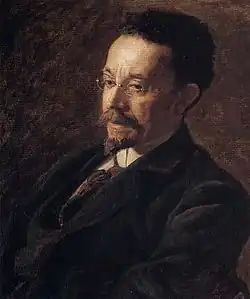
Henry Ossawa Tanner was born in Pittsburgh, Pennsylvania, the first of nine children; two brothers, Benjamin and Horace, died in infancy.[9] One of his sisters, Halle Tanner Dillon Johnson, was the first woman to be certified to practice medicine in Alabama.[10] His parents gave him a middle name that commemorated the struggle at Osawatomie between pro- and anti-slavery partisans.[11] His father Benjamin Tucker Tanner (1835–1923) became a bishop in the African Methodist Episcopal Church (AME), the first independent black denomination in the United States. He was educated at Avery College and Western Theological Seminary in Pittsburgh, and developed a literary career.[12] In addition, he was a political activist, supporting abolition of slavery. Henry Tanner's mother Sarah Elizabeth Tanner may have been born into slavery in Virginia.[13][14] Two different stories have emerged concerning her living in freedom; in one, her father drives the family from Winchester, Virginia to "the free state of Pennsylvania" in an ox cart.[13] In the other, she escapes as a refugee to the North via the Underground Railroad.[14] There she met and married Benjamin Tucker Tanner.[13]
The family moved from Pittsburgh to Philadelphia when Tanner was a teenager.[15] There his father became a friend of Frederick Douglass, sometimes supporting him, sometimes criticizing.[16] Robert Douglass, Jr., a successful black artist in Philadelphia, was an early neighbor of the Tanner family, and Tanner wrote that he "used to pass and always stopped to look at his pictures in the window."[17] When Tanner was about 13 years old, he saw a landscape painter working in Fairmount Park, where he was walking with his father. He decided that he wanted to be a painter.[9]
Education
.jpg.webp)
Although many artists refused to accept an African-American apprentice, in 1879 Tanner enrolled at the Pennsylvania Academy of the Fine Arts in Philadelphia, becoming the only black student.[16] His decision to attend the school came at a time when art academies increasingly focused on study from live models rather than plaster casts. Thomas Eakins, a professor at the Pennsylvania Academy, was one of the first American artists to promote new approaches to artistic education including increased study from live models, discussion of anatomy in classes of both male and female students, and dissections of cadavers to teach anatomy. Eakins's progressive approach to art education had a profound effect on Tanner. The young artist was one of Eakins' favorite students; two decades after Tanner left the Academy, Eakins painted his portrait.[18]
At the Academy, Tanner befriended artists with whom he kept in contact throughout the rest of his life, most notably Robert Henri, one of the founders of the Ashcan School. During a relatively short time at the Academy, Tanner developed a thorough knowledge of anatomy and the skill to express his understanding of the weight and structure of the human figure on the canvas.[2]
Tanner's artistic studies were disrupted by illness, which was reported in November 1881 and said to have persisted into the following summer, when Tanner spent time recovering in the Adirondack mountains.[19]
Issues of racism

Although Tanner gained confidence as an artist and began to sell his work, he faced racism working as a professional artist in Philadelphia.[20] In his autobiography, The Story of an Artist's Life, Tanner described the burden of racism:
I was extremely timid and to be made to feel that I was not wanted, although in a place where I had every right to be, even months afterwards caused me sometimes weeks of pain. Every time any one of these disagreeable incidents came into my mind, my heart sank, and I was anew tortured by the thought of what I had endured, almost as much as the incident itself.[21]
Life abroad

In the hope of earning enough money to travel to Europe, Tanner operated a photography studio in Atlanta during the late 1880s. The venture was unsuccessful. During this period Tanner met Bishop Joseph Crane Hartzell, a trustee of Clark College (now Clark Atlanta University). Hartzell and his wife befriended Tanner, became his patrons, and recommended him for a teaching job at the college.[22] Tanner taught drawing at Clark College for a short period.[23]
In 1891, he traveled to Paris, France,[15] to study at the Académie Julian. He also joined the American Art Students Club. Paris was a welcome escape for Tanner; within French art circles, race mattered little. Tanner acclimated quickly to Parisian life. There he met Atherton Curtis who became a friend and a patron of his art.[24][25]

He was part of a community of artists in Mount Kisco, New York for six months in 1902, at the behest of Curtis, and returned the following winter.[26] Except for occasional brief returns home, Tanner spent the rest of his life in Paris. There he was introduced to many artists whose works would affect his approach to art. At the Louvre, he encountered and studied the works of Gustave Courbet, Jean-Baptiste Chardin and Louis Le Nain.[27] These artists had painted scenes of ordinary people in their environment, and the influence in Tanner's work is noticeable. That of Courbet's The Stone Breakers (1850; destroyed) can be seen in the similarities in Tanner's The Young Sabot Maker (1895). Both paintings explore the themes of apprenticeship and manual labor.[27]
Tanner continued his studies under renowned artists such as Jean Joseph Benjamin Constant and Jean-Paul Laurens.[21] With their guidance, Tanner began to establish a reputation in France. He settled at the Étaples art colony in Normandy.
Earlier, Tanner had painted marine scenes of man's struggle with the sea, but by 1895 he was creating mostly religious works. His shift to painting biblical scenes occurred as he was undergoing a spiritual struggle. In a letter he wrote to his parents on Christmas 1896, he stated, "I have made up my mind to serve Him [God] more faithfully."[28] A transitional work from this period is the recently rediscovered painting of a fishing boat tossed on the waves, which is held by the Smithsonian American Art Museum.[29]

This is based on the description of a miracle in the Gospel of Matthew in which "the boat was now in the middle of the sea, tossed by the waves, for the wind was contrary" (14:24). The simple resources at Étaples were well adapted to his subject matter, which in several cases featured biblical figures in dark interiors.
Tanner's painting Daniel in the Lions' Den was accepted into the 1896 Salon.[2] Later that year he painted The Resurrection of Lazarus.[30] The critical praise for this piece solidified Tanner's position in the artistic elite and heralded the future direction of his paintings, which treated mostly biblical themes. Upon seeing The Resurrection of Lazarus,[31] art critic Rodman Wanamaker offered to pay all the expenses for a journey by Tanner to the Middle East.[2] Wanamaker felt that any serious painter of biblical scenes needed to see the environment firsthand and that a painter of Tanner's caliber was well worth the investment.
Tanner quickly accepted the offer. Before the next Salon opened, he set forth for the Palestine region of the Levant. Explorations of various mosques and biblical sites, as well as character studies of the local population, allowed him to further his artistic training. His paintings developed a powerful air of mystery and spirituality. Tanner was not the first artist to study the Middle East in person: since the 1830s, interest in Orientalism had been growing in Europe. Artists such as Eugène Delacroix, David Roberts and, later, Henri Matisse made such tours to capitalize on this curiosity.[2]
In his adopted home of France, in 1923 Tanner was appointed Chevalier of the Legion of Honor, the highest national order of merit. He considered this "citation by the French government to be the greatest honor of his illustrious career."[32]
The Banjo Lesson
.jpg.webp)
On a short return visit to the United States in 1893, Tanner painted The Banjo Lesson, while in Philadelphia. Considered his most well-known work, the painting shows an elderly black man teaching a boy, assumed to be his grandson, how to play the banjo. This quiet composition explores several important themes. The image of a black man playing the banjo appears throughout American art of the late 19th century. Thomas Worth,[33] Willy Miller, Walter M. Dunk, Eastman Johnson, and Tanner's teacher Thomas Eakins had all tackled the subject in their artwork.[27]
Tanner created a sensitive moment of human interaction. The old man and young boy are shown engaged in a concentrated activity, oblivious to the rest of the world, sharing a sense of contact and cooperation. Tanner portrays the sitters as individuals with portrait-like detail.
Tanner's muted palette creates a peaceful scene that emphasizes modesty and family.[34] There are two separate and varying light sources: A natural white, blue glow from outside enters from the left, while the warm light from a fireplace is apparent on the right. The figures are illuminated where the two light sources meet; some have hypothesized this as a manifestation of Tanner's situation in transition between two worlds, his American past and his newfound home in France.[27]
Painting style
Tanner painted landscapes, religious subjects, and scenes of daily life in a realistic style that echoed that of Eakins.[35][36] While works like The Banjo Lesson depicted everyday scenes of African American life, Tanner later painted religious subjects.[23] It is likely that Tanner's father, a minister in the African Methodist Episcopal Church, was a formative influence for him.[2]
Tanner was not limited to one specific approach to painting and drawing. His works reflect at times meticulous attention to detail and loose, expressive brushstrokes in others. Often both methods are employed simultaneously. Tanner was also interested in the effects that color could have in a painting.[37] Warmer compositions such as The Resurrection of Lazarus (1896) and The Annunciation (1898) express the intensity and fire of religious moments, and the elation of transcendence between the divine and humanity. Other paintings emphasize cool hues, which became dominant in his work after the mid-1890s. A palette of indigo and turquoise—referred to as the "Tanner blues"—characterizes works such as The Three Marys (1910), Gateway (1912) and The Arch (1919).[34] Works such as The Good Shepherd (1903) and Return of the Holy Women (1904) evoke a feeling of somber religiosity and introspection.
Tanner often experimented with light in his works, which at times adds symbolic meaning. In The Annunciation (1898), for example, the archangel Gabriel is represented as a column of light that forms, together with the shelf in the upper left corner, a cross.[38]
Marriage and family

In 1899 he married Jessie Olsson, a Swedish-American opera singer.[39] A contemporary, Virginia Walker Course, described their relationship as one of equal talents, but racist attitudes insisted the relationship was unequal:
Fan, did you ever hear of a miss [sic] Olsson of Portland? She has a beautiful voice I believe and came to Paris to cultivate it and she has married a darkey artist ... He is an awefully [sic] talented man but he is black. ... She seems like a well educated girl and really very nice but it makes me sick to see a cultivated woman marry a man like that. I don't know his work but he is very talented they say.[40]
Jessie Tanner died in 1925, twelve years before her husband, and he grieved her deeply through the 1920s. He sold the family home in Les Charmes where they had been so happy together. They are buried next to each other in Sceaux, Hauts-de-Seine.[41]
They had a son, Jesse, who survived Tanner at his death.[23]
Later years

During World War I, Tanner worked for the Red Cross Public Information Department, during which time he also painted images from the front lines of the war.[42] His works featuring African-American troops were rare during the war. In 1923 the French state made him a knight of the Legion of Honour for his work as an artist.
Tanner met with fellow African-American artist Palmer Hayden in Paris circa 1927. They discussed artistic technique and he gave Hayden advice on interacting with French society.[43]
Several of Tanner's paintings were purchased by Atlanta art collector J. J. Haverty, who founded Haverty Furniture Co. and was instrumental in establishing the High Museum of Art. Tanner's Étaples Fisher Folk is among several paintings from the Haverty collection now in the High Museum's permanent collection.
Tanner died peacefully at his home in Paris, France, on May 25, 1937.[42] He is buried at Sceaux Cemetery in Sceaux, Hauts-de-Seine, which is a suburb of Paris.
Legacy

Tanner's work was influential during his career; he has been called "the greatest African American painter to date."[45] The early paintings of William Edouard Scott, who studied with Tanner in France, show the influence of Tanner's technique.[27] In addition, some of Norman Rockwell's illustrations deal with the same themes and compositions that Tanner pursued. Rockwell's proposed cover of the Literary Digest in 1922, for example, shows an older black man playing the banjo for his grandson. The light sources are nearly identical to those in Tanner's Banjo Lesson. A fireplace illuminates the right side of the picture, while natural light enters from the left. Both use similar objects as well such as the clothing, chair, crumpled hat on the floor.[27] Some other major artists Tanner mentored include William A. Harper and Hale Woodruff.[9]
Tanner's Sand Dunes at Sunset, Atlantic City (c. 1885; oil on canvas) hangs in the Green Room at the White House; it is the first painting by an African-American artist to have been purchased for the permanent collection of the White House. The painting is a landscape with a "view across the cool gray of a shadowed beach to dunes made pink by the late afternoon sunlight. A low haze over the water partially hides the sun." It was bought for $100,000 by the White House Endowment Fund during the Bill Clinton administration from Dr. Rae Alexander-Minter, grandniece of the artist.[46]
His correspondence with Curtis between 1904 and 1937 is held at the Smithsonian Institution.[47]
Tanner's work was included in the 2015 exhibition We Speak: Black Artists in Philadelphia, 1920s-1970s at the Woodmere Art Museum.[48]
Awards

- 1895, Atlanta, Cotton States and International Exposition: bronze medal for The Bagpipe Lesson.[49]
- 1896, Salon: honorable mention[50] for Daniel in the Lions' Den[51]
- 1897, Salon: third class medal[50] for Raising of Lazarus[52]
- 1899, Philadelphia Academy of Fine Art: Walter Lippincott prize[50] for Christ and Nicodemus on a Rooftop[52]
- 1900, Paris Exposition: silver medal[50][53] for Daniel in the Lions' Den[51]
- 1901, Buffalo Exposition: silver medal[50][53] for Daniel in the Lions' Den[51]
- 1904, St. Louis Exposition: silver medal[50][53] for Daniel in the Lions' Den[51]
- 1906, Salon: second class medal for The Disciples at Emmaus}[51]
- 1906, Art Institute of Chicago, Norman Wait Harris silver medal for The Two Disciples at the Tomb[50][54][52]
- 1915, Panama–Pacific International Exposition, San Francisco: gold medal[50][53] for Christ at the Home of Lazarus[51] (This link is to the study, not the final painting).
- 1922, France: Knighthood of the Legion of Honor[50] for his efforts in World War I, part of the Red Cross
- 1927, New York, National Arts Club: bronze medal for Flight into Egypt (At the Gates)[51]
- 1930, New York City, Grand Central Art Gallery: Walter L. Clark prize for Etaples Fisher Folk[52][51]
Exhibitions

- 1972: The Art of Henry Ossawa Tanner. Glen Falls, New York: The Hyde Collection.
- 1972: 19th Century American Landscape. New York: Metropolitan Museum of Art.
- 1976: Two Centuries of Black American Art. Los Angeles County Museum of Art.
- 1989: Black Art Ancestral Legacy: The African Impulse in African-American Art. Dallas Museum of Art.
- 1993: Revisiting the White City: American Art at the 1893 World's Fair[33]
- 2010: Henry Ossawa Tanner and his Contemporaries,[55] Des Moines Art Center (December–February 2011).
- 2012: Henry Ossawa Tanner: Modern Spirit,[56] Pennsylvania Academy of the Fine Arts, Philadelphia (January–April), then to Cincinnati Art Museum[57] (May–September) and to Houston Museum of Fine Arts (October–January 2013)
Selected works

- Seascape-Jetty (c. 1876–78)
- Pomp at the Zoo (1880). Private Collection
- Joachim Leaving the Temple (c. 1882–1888). Baltimore Museum of Art
- Boy and Sheep Lying under a Tree (1881). Private Collection (On display at the Philadelphia Museum of Art)
- Sand Dunes at Sunset, Atlantic City (1886). Estate of Sadie T. M. Alexander (On permanent display at the White House)
- The Bagpipe Lesson (1893). Hampton University Museum, Virginia
- The Banjo Lesson (1893). Hampton University Museum, Virginia
- The Thankful Poor (1894). Art Bridges[58]
- The Young Sabot Maker (1895). The Nelson-Atkins Museum of Art, Kansas City, Missouri
- Daniel in the Lions' Den (1895). Los Angeles County Museum of Art
- The Resurrection of Lazarus (1896). Musée d'Orsay, Paris
- Bishop Benjamin Tucker Tanner (1897). Baltimore Museum of Art
- Lions in the Desert (c. 1897–1900). Smithsonian American Art Museum
- The Annunciation (1898). Philadelphia Museum of Art, W.P. Wilstach Collection
- Moonlight Landscape (1898–1900). Muscarelle Museum of Art, Williamsburg, VA.[59]
- The Good Shepherd (1903). Jane Voorhees Zimmerli Art Museum, Rutgers University
 Portrait of Henry Ossawa Tanner by V. Floyd Campbell
Portrait of Henry Ossawa Tanner by V. Floyd Campbell - Return of the Holy Women (1904). Cedar Rapids Art Gallery, Iowa
- Two Disciples at the Tomb (1905–06). Art Institute of Chicago
- The Visitation (1909–10). Kalamazoo Institute of Arts
- The Holy Family (1909–10). Muskegon Museum of Art, Michigan, Hackley Picture Fund
- Moroccan Scene (about 1912). Birmingham Museum of Art, Alabama
- Palace of Justice, Tangier (1912–13). Smithsonian American Art Museum[60]
- Scene in Cairo. Mabee-Gerrer Museum of Art, Shawnee, Oklahoma
Other works
 Pomp at the zoo, circa 1880
Pomp at the zoo, circa 1880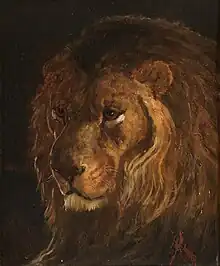 Pomp at the Philadelphia Zoo, circa 1880-1886
Pomp at the Philadelphia Zoo, circa 1880-1886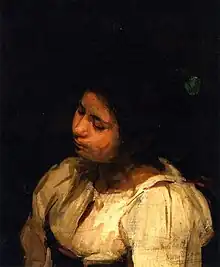 Sister Sarah, 1882.
Sister Sarah, 1882. Woman from the West Indies, 1891, Brittany, France.[61]
Woman from the West Indies, 1891, Brittany, France.[61]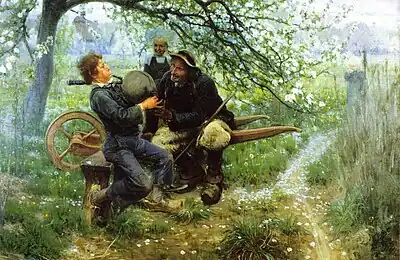 The Bagpipe Lesson, 1893
The Bagpipe Lesson, 1893 The Young Sabot Maker, 1895
The Young Sabot Maker, 1895 1895. Marshes in New Jersey; possibly the "pastel of New Jersey coast by moonlight" exhibited at the 1895 Salon with The Young Sabot Maker.[51]
1895. Marshes in New Jersey; possibly the "pastel of New Jersey coast by moonlight" exhibited at the 1895 Salon with The Young Sabot Maker.[51] The Annunciation to the Shepherds, c. 1895
The Annunciation to the Shepherds, c. 1895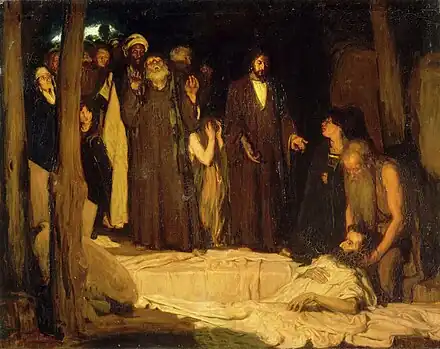 The Resurrection of Lazarus, 1896. Won medal in 1897 Paris Salon, bought by French government.
The Resurrection of Lazarus, 1896. Won medal in 1897 Paris Salon, bought by French government. View of the Seine, looking toward Notre Dame, 1896
View of the Seine, looking toward Notre Dame, 1896 Jesus and Nicodemus, 1899. Displayed at Paris Salon and Pennsylvania Academy of Fine Arts, where won a Walter Lippincott Prize.
Jesus and Nicodemus, 1899. Displayed at Paris Salon and Pennsylvania Academy of Fine Arts, where won a Walter Lippincott Prize.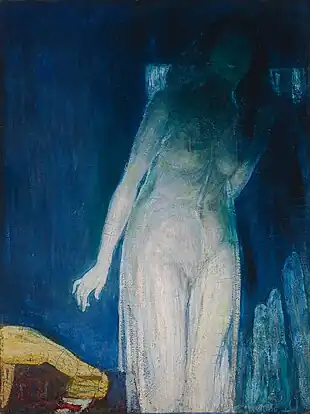 Salome, circa 1900. The body of John the Baptist lies at her feet.
Salome, circa 1900. The body of John the Baptist lies at her feet. Abraham's Oak, 1905. Biblical subject, also called the Oak of Mamre.
Abraham's Oak, 1905. Biblical subject, also called the Oak of Mamre.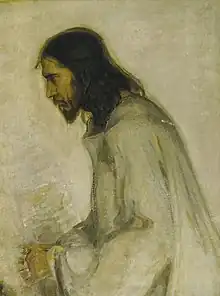 The Savior, 1900-1905
The Savior, 1900-1905 Christ in the home of Mary and Martha, 1905
Christ in the home of Mary and Martha, 1905 The Disciples See Christ Walking on the Water, c. 1907
The Disciples See Christ Walking on the Water, c. 1907 Angels Appearing before the Shepherds, circa 1910
Angels Appearing before the Shepherds, circa 1910 Christ walking on the water. Engraving, possibly a show catalog, 1910.
Christ walking on the water. Engraving, possibly a show catalog, 1910.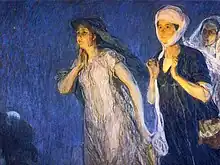 The Three Marys (at Jesus' tomb), 1910. Entered in the 1910 Salon. (From left) Mary Magdalene, Mary, mother of Jesus, Mary Salome
The Three Marys (at Jesus' tomb), 1910. Entered in the 1910 Salon. (From left) Mary Magdalene, Mary, mother of Jesus, Mary Salome A View of Fez, c. 1912
A View of Fez, c. 1912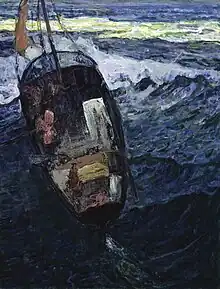 Fishermen at Sea, c. 1913
Fishermen at Sea, c. 1913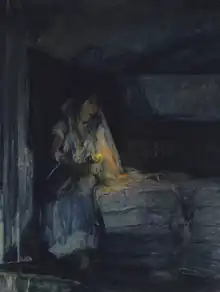 Mary, 1914
Mary, 1914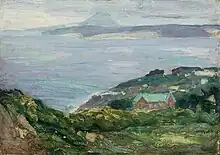 Coastal Landscape, France, 1919
Coastal Landscape, France, 1919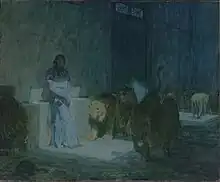
 1936. Tanner's final painting, Return from the Crucifixion. Mary and Joseph are in the front.
1936. Tanner's final painting, Return from the Crucifixion. Mary and Joseph are in the front.
 Sand Dunes at Sunset, Atlantic City, c. 1885, the White House.
Sand Dunes at Sunset, Atlantic City, c. 1885, the White House. Destruction of Sodom and Gomorrah, 1929–30, High Museum of Art
Destruction of Sodom and Gomorrah, 1929–30, High Museum of Art
See also
References
- ↑ "Henry Ossawa Tanner". Archived from the original on May 27, 2011. Retrieved August 5, 2006.
- 1 2 3 4 5 6 Matthews, Marcia. Henry Ossawa Tanner: American Artist. Chicago: The University of Chicago Press, 1969.
- ↑ Mathews, Marcia M. (1995). Henry Ossawa Tanner: American Artist. University of Chicago Press. ISBN 0-226-51006-9.
- ↑ "Artist Info". www.nga.gov. Retrieved November 25, 2021.
- ↑ Mosby, Dewey F. (1991). Henry Ossawa Tanner. Philadelphia Museum of Art. Philadelphia; New York: Philadelphia Museum of Art; Rizzoli International Publications. p. 50. ISBN 978-0-8478-1346-9.
- ↑ "Henry Ossawa Tanner". Smithsonian American Art Museum. Retrieved November 25, 2021.
- ↑ Mosby, Dewey F. (1991). Henry Ossawa Tanner. Philadelphia Museum of Art. Philadelphia; New York: Philadelphia Museum of Art; Rizzoli International Publications. p. 30. ISBN 978-0-8478-1346-9.
- ↑ "Henry Ossawa Tanner". Smithsonian American Art Museum. Retrieved November 25, 2021.
- 1 2 3 Woods, Naurice Frank (2018). Henry Ossawa Tanner Art, Faith, Race, and Legacy. New York, NY: Taylor and Francis. ISBN 978-1-138-24194-7.
- ↑ Wright, A. J. (May 18, 2017). "Halle Tanner Dillon". Encyclopedia of Alabama. Retrieved November 8, 2020.
- ↑ Kelly Jeanette Baker (2003). "Race, Religion, and Visual Mysticism". Florida State University.
- ↑ The Civil War in America: Benjamin Tucker Tanner, Library of Congress Exhibitions
- 1 2 3 Homespun Heroines and other women of distinction. New York: Oxford University Press. 1988. pp. 32–33.
- 1 2 "Mother of Henry O. Tanner". Smithsonian American Art Museum.
- 1 2 Angelica Villa (November 29, 2022). "Preservationists Move to Save Painter Henry Ossawa Tanner's Childhood Home in Philadelphia". ARTnews.
- 1 2 Finkelman, Paul, ed. (2006). Encyclopedia of African American History 1619–1895. Vol. 3. New York: Oxford University Press. p. 224.
- ↑ Tanner, Henry Ossawa; Marley, Anna O. (2012). Henry Ossawa Tanner: Modern Spirit. Univ of California Press. p. 19. ISBN 978-0-520-27074-9.
- ↑ Parry, Ellwood C. III. Three Nineteenth Century Afro-American Artists. Cedar Rapids, IA: Cedar Rapids Art Center, 1980.
- ↑ Woods, Naurice Frank Jr. (July 6, 2017). Henry Ossawa Tanner: Art, Faith, Race, and Legacy. Taylor & Francis. p. 29. ISBN 978-1-315-27948-0.
- ↑ "Henry Ossawa Tanner | Smithsonian American Art Museum". americanart.si.edu. Retrieved June 4, 2021.
- 1 2 Bruce, Marcus C. Henry Ossawa Tanner. New York: Crossroad Publishing, 2002.
- ↑ Matthews, Marcia (1994). Henry Ossawa Tanner: American Artist. Chicago: The University of Chicago Press. p. 36. ISBN 0-226-51006-9.
- 1 2 3 "Henry Ossawa Tanner". Springfield Museum of Art. Archived from the original on January 10, 2006. Retrieved August 5, 2006.
- ↑ Woods, Naurice Frank Jr. (2018). Henry Ossawa Tanner: Art, Faith, Race, and Legacy. Taylor & Francis. ISBN 978-1-315-27948-0.
- ↑ Bearden, Romare; Henderson, Harry Brinton (1972). Six Black Masters of American Art. Zenith Books. p. 55. ISBN 978-0-385-01211-9.
- ↑ "Atherton Curtis letter to Jessie Tanner after the death of H. O. Tanner in 1937".
- 1 2 3 4 5 6 Shaw, Thomas M. What Manner of Men? A Reconsideration across the Synapses of Art History of Three Paintings and their Images of Men of African Descent. Lanham, MD: University Press of America, 1997.
- ↑ Woods, Naurice Frank. "Embarking on a New Covenant: Henry Ossawa Tanner's Spiritual Crisis of 1896." American Art, vol. 27, no. 1, 2013, pp. 94–103. JSTOR, www.jstor.org/stable/10.1086/670686.
- ↑ Details on the museum site
- ↑ "Negro Artist site". Negroartist.com. Retrieved December 14, 2013.
- ↑ "Negro Artist site". Negroartist.com. Retrieved December 14, 2013.
- ↑ Mosby, Dewey F.; Sewell, Darrell; Alexander-Minter, Rae (1991). Henry Ossawa Tanner: catalogue. Philadelphia, PA: Philadelphia Museum of Art. p. 32. ISBN 0-87633-086-3.
- 1 2 Woods, Naurice Frank, Jr., Ph.D. Insuperable Obstacles: The Impact of the Creative and Personal Development of Four Nineteenth Century African American Artists. The Union Institute, 1993.
- 1 2 Farrington, Lisa (2017). African-American Art A visual and Cultural History. New York, New York: Oxford University Press. pp. 97–98. ISBN 978-0-19-999539-4.
- ↑ "Henry Ossawa Tanner Online". Retrieved August 5, 2006.
- ↑ "Realism – Realism Art". Archived from the original on October 7, 2009. Retrieved August 5, 2006.
- ↑ Kettlewell, James K. The Art of Henry Ossawa Tanner. Glen Falls, NY: The Hyde Collection, 1975.
- ↑ "Teacher Resources: The Annunciation" (PDF). The Annunciation, Henry Ossawa Tanner. Philadelphia Museum of Art. Retrieved June 6, 2016.
- ↑ Marley, Anna O. "Introduction" in Modern Spirit Pennsylvania Academy of the Fine Arts. Philadelphia. 2012.
- ↑ Course, Virginia Walker qtd. by Jean-Claude Lesage in "Tanner, the Pillar of Trepied". Modern Spirit. Pennsylvania Academy of the Fine Arts. Philadelphia. 2012, p. 88.
- ↑ Marley (2012), p. 41.
- 1 2 "Henry Ossawa Tanner". Archived from the original on August 29, 2006. Retrieved August 9, 2006.
- ↑ Finkelman, Paul, ed. (2009). Encyclopedia of African American History (1896 to the present). Vol. 2. New York: Oxford University Press. p. 393.
- ↑ "A modest improvement at the National Gallery | Tyler Green: Modern Art Notes | ARTINFO.com". Blogs.artinfo.com. February 3, 2012. Retrieved December 14, 2013.
- ↑ Finkelman, Paul, ed. (2006). Encyclopedia of African American History 1619–1895. Vol. 1. New York: Oxford University Press. p. 101.
- ↑ "White House Announces Acquisition of Henry Ossawa Tanner Painting for Permanent White House Collection" Archived July 16, 2011, at the Wayback Machine. Life in the White House.
- ↑ "Henry Ossawa Tanner correspondence with Atherton Curtis and Ingeborg Curtis (1904–1937)".
- ↑ "We Speak: Black Artists in Philadelphia, 1920s-1970s". Woodmere Art Museum. Retrieved June 12, 2022.
- ↑ Carlyn G. Crannell Romeyn (Winter 1983–1984). "Henry O. Tanner: Atlanta Interlude". The Atlanta Historical Journal. 27 (4): 38.
On the other hand, it is possible that some of tanner's Atlanta friends secured the three works (including The Bagpipe Lesson which won a bronze medal) for this exposition.
- 1 2 3 4 5 6 7 8 9 "Henry Ossawa Tanner — Artist". The Northwestern Bulletin-Appeal. Saint Paul, Minnesota. July 25, 1925. p. 2.
- 1 2 3 4 5 6 7 8 9 Mosby, Dewey F. (1991). Henry Ossawa Tanner. Philadelphia Museum of Art. Philadelphia; New York: Philadelphia Museum of Art; Rizzoli International Publications. p. 39. ISBN 978-0-8478-1346-9.
1895 May. Paris, Salon. Intérieur Bretagne [Brittany Interior], Le Jeune Sabotier [The Young Sabot Maker], pastel of New Jersey coast by moonlight.
- 1 2 3 4 "Henry Ossawa Tanner 1859/1937". Detroit Free Press. July 14, 1991. pp. 284–285.
- 1 2 3 4 "Noted artist dies abroad". Pittsburgh Post-Gazette. Pittsburgh, Pennsylvania. May 27, 1937. p. 17.
- ↑ American Oil Paintings and Sculpture: 28th Annual Art Exhibition, Art Institute of Chicago November 16, 1915 to January 2, 1916.
- ↑ "Henry Ossawa Tanner and his Contemporaries" Archived April 19, 2012, at the Wayback Machine, Des Moines Art Center.
- ↑ "Henry Ossawa Tanner: Modern Spirit", PAFA.
- ↑ "Upcoming Exhibitions". Archived from the original on July 3, 2014. Retrieved April 1, 2015.
- ↑ "The Thankful Poor". Art Bridges. Retrieved March 3, 2021.
- ↑ "Moonlight Landscape, (oil on canvas)". Art in Bloom. Muscarelle Museum of Art. 2016. Retrieved June 20, 2018.
- ↑ "Palace of Justice, Tangier, Morocco". World Digital Library. 1890–1900. Retrieved June 27, 2013.
- ↑ "Henry Ossawa Tanner Lot 41: Henry Ossawa Tanner, (American, 1859-1937), Woman from the French West Indies, c. 1891".
The artist arrived in Paris, France at this time and spent the summers on the west coast in Brittany. There, he adopted a predominately green palette with an emphasis on vertical brushstrokes as can be seen in the Woman from the French West Indies...we are looking at an image of a light-skinned woman from one of the islands of the French West Indies-Martinique, Guadeloupe or Dominica. This claim is supported by her costume and headdress.
- ↑ Mathews, Marcia M (1969). Henry Ossawa Tanner, American artist. Chicago: University of Chicago Press. pp. 69–74.
- ↑ Henry Ossawa Tanner (July 1909). "The Story of an Artist's Life: II Recognition". The World's Work. Vol. 18, no. 3. Open Court Publishing Co. p. 11772.
In 1895, I painted " Daniel in Lions' Den."...It was exhibited in the Salon of 1896..
External links
- White House Biography
- Springfield Museum of Art Biography
- Ebony Society of Philatelic Events and Reflections Biography
- Muskegon Museum of Art
- Profile at PBS.org
- Henry Ossawa Tanner: Modern Spirit (University of California Press, 2012)—the most complete scholarly publication to date produced in conjunction with the Pennsylvania Academy of Fine Arts (PAFA), Tanner's alma mater
- Biographical sketch and gallery at the Smithsonian American Art Museum
- Art online
- Henry Ossawa Tanner Papers
- Alexander family papers relating to Henry Ossawa Tanner, 1912–1985
- Gallery of images and letters from the PAFA archives Archived April 3, 2012, at the Wayback Machine
- Henry Ossawa Tanner papers, 1860s–1978, bulk 1890–1937. Archives of American Art, Smithsonian Institution.
